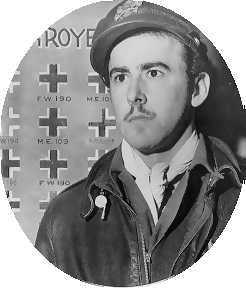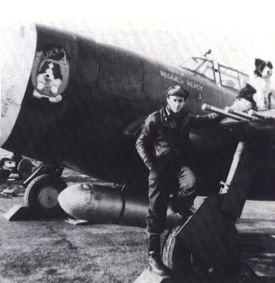Major John T. Godfrey

I gained in experience with every plane shot
down, and now was able to
fire in a calm, deliberate manner. Each attack was made in a precise
manner. Distance and deflection were carefully judged before firing.
This is not something that comes by accident; only by experience can a
pilot overcome feelings of panic. A thousand missions could be flown and
be of no use if the pilot had not exchanged fire with the enemy.
Major John T. Godfrey, USAAF
 Major John Godfrey was destined to
become an outstanding American warrior, to destroy more enemy aircraft than any other
pilot in the 4th and to become a national hero in whose honor factory whistles were blown,
military parades staged and war bond rallies held. But at home, in his 'teens, Godfrey was
the subject of many anxious family consultations.
Major John Godfrey was destined to
become an outstanding American warrior, to destroy more enemy aircraft than any other
pilot in the 4th and to become a national hero in whose honor factory whistles were blown,
military parades staged and war bond rallies held. But at home, in his 'teens, Godfrey was
the subject of many anxious family consultations.
Born in Canada but brought up in Woonsocket, RI, his parents were
prosperous people who were troubled because he wouldn't go to college and take his higher
learning like a man. In fact, he just wouldn't stay in high school. He was moody,
reckless and appeared to be shiftless. His salient feature was his set of darting, gypsy
black eyes. They later proved the keenest eyes in the 4th, disciplined, radar eyes that
could spot enemy specks in the sky miles away. But in 1940, they had a restless, faraway
expression that reflected Godfrey's maladjustment.
At 18, Godfrey ran away from home to Canada to join the Montreal
Regiment. His father retrieved him and he went to work in the Navy yard at Providence, RI.
Soon he left again, but this time his father, with a better idea of
where to look, overtook him before he got farther than the Boston station. But Godfrey
still rebelled at going to college.
August 11, 1941, his despairing parents made a covenant with him. It was
agreed that he could go to Canada and try to enter the RCAF to become a fighter pilot. If
he failed he would come back and go to college. He never went to college.
Soon after his acceptance by the RCAF, his Canadian colonel
unaccountably directed him to take a two weeks leave. Once at home he learned why. His
father and mother met him at the station and told him that his brother, Reginald, an
airplane technician, had been torpedoed by the Germans as he sailed to England.
The recklessness and perverse rebelliousness that had handicapped
Godfrey in civilian life found an outlet in war, as so often happened, and were
mainsprings in the equipment which made him one of the AAF's great pilots. These qualities
were tempered with grimness over his brother's death at the hands of the
Germans. He painted "Reggie's Reply" on his plane. The reply was such that
after the war the French government exhibited his plane in Paris under the Eiffel Tower.
Godfrey and his close friend Capt.
"Don" Gentile flew with a group from the 4th Fighter Group of the 336th
Fighter Squadron flying out of Debden. They tormented Hermann Göring's Luftwaffe to such
an extent that Göring called them the"Debden Gangsters". Between Gentile and
Godfrey they had 37 kills. Gentile and Godfrey used rather unconventional tactics; tactics
which would in later years be used by American fighter pilots in Vietnam (read an excerpt from Godfrey's book which describes these tactics).
Whoever first spotted a target and was in the best position, took the lead with the other
covering his "six". The Gentile-Godfrey combination was so effective the Göring
is said to have sworn he'd give up two squadrons for their capture.
Major Godfrey was shot down 8 miles northeast of Nordhausen, Germany,
when he was hit by his wingman's gunfire and bellied in. He spent several months in
a prison camp, but managed to escape just before the end of the war.
After the war Major Godfrey took up residence in Coventry, Rhode Island
where he worked for his father-in-law in his lace mill. Later, he was owner of his
own lace mills (Godfrey's Laces) and was R.I. State Senator. He was approached to
run for Governor but declined. In 1954 he moved his family (wife and 2 sons) and
business to South Freeport Maine. He passed away June 12, 1958, in South Freeport of
Amyotrophic Lateral Sclerosis (Lou Gehrig's Disease).

Capt. Godfrey with "Reggie's Reply" & mascot
A brief history of the 4th fighter group
Aces Home
Page | U. S. Fighter Home Page | Feedback
 Major John Godfrey was destined to
become an outstanding American warrior, to destroy more enemy aircraft than any other
pilot in the 4th and to become a national hero in whose honor factory whistles were blown,
military parades staged and war bond rallies held. But at home, in his 'teens, Godfrey was
the subject of many anxious family consultations.
Major John Godfrey was destined to
become an outstanding American warrior, to destroy more enemy aircraft than any other
pilot in the 4th and to become a national hero in whose honor factory whistles were blown,
military parades staged and war bond rallies held. But at home, in his 'teens, Godfrey was
the subject of many anxious family consultations. 